By Rayna Chou
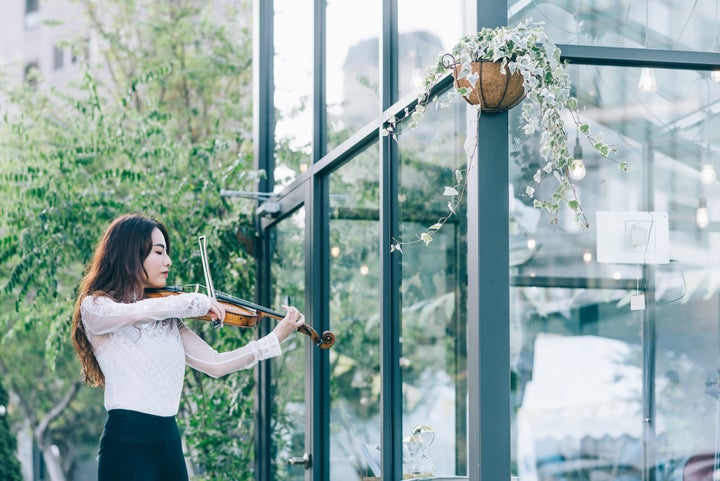
We all have so many things to do every day and twenty-four hours often seems like not enough time. Would you be willing to share a small room with a stranger for one minute during your busy day? And what if that stranger is a classical musician who is playing right in front of you?
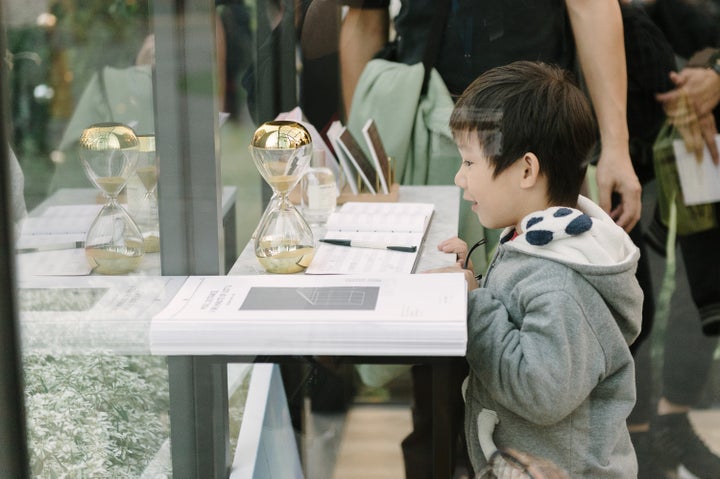
Last year, I was deeply inspired by a Winston Churchill quote my teacher shared with our class: “Courage is what it takes to stand up and speak; courage is also what it takes to sit down and listen.” The inspiration grew into a question, and that question led to my exhibition “Music, Distance, and One Minute of Just Us.” It was a two-week project that brought music, visual arts, and architecture together to create a social experiment in my hometown, Taichung City, Taiwan. It was a much bigger project than I anticipated, but I wanted so badly to answer my question. And, I am glad to say that I now have three thousand four hundred and sixty-nine answers to the question. But, let me start from the very beginning.

I believe life is about all those truly special moments and we, as musicians, have the ability and responsibility to create them. But, in the last decade, I have watched my old school close their once prestigious music department, orchestras go bankrupt, and young audiences turn away from classical music. In Taiwan, not only is classical music a foreign art, but being a musician is not considered an ideal career either. Most people assume classical music is out of their league, exclusive, for the elite, and too difficult for them to understand; others think classical music is boring and unnecessarily expensive for something that doesn’t provide a tangible gain. On the other hand, because of the unfairly low wages (as low as $17 an hour for a conservatory trained teacher) and low concert attendance, musicians can’t help but feel disappointed and isolated.
It is tempting for us to blame the loss of support on the mainstream audience and how they never gave us a chance. But, when I look around in our music world, I see closed doors. We distance ourselves from the non-listeners, as if we are afraid of being rejected and judged for the music we poured our hearts and souls into. What if I could create a space where there is no hierarchy, no pride, and no judgement? A space where the musician does not play to be paid and the audience does not listen to be impressed? A space where I can actually see your face, and you can look into my eyes.
With the support from my collaborators and New England Conservatory’s Entrepreneurial Musicianship department, I spent six months planning through online conferencing from Boston to Taichung, and also sourced all of my materials. I partnered with an architect who brought my sketches to life; we designed two free standing glass rooms that would stand in one of the busiest plazas in Taichung City. The rooms share the same shape and they are the same size as a regular practice room. Identical, yet one of them is clear and lit up by bright bulbs, while the other is covered with black mirrored glass. The construction ended up taking less than a month, and with the help of landscape designers, the entire structure went beyond anyone’s expectations.
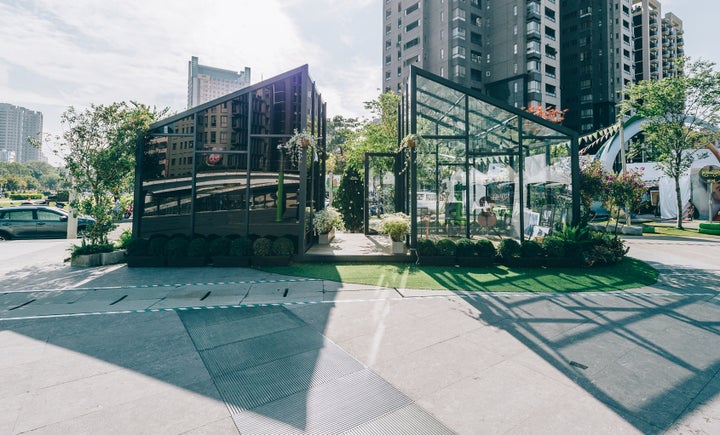
I wanted it to be a two-part experience for visitors of all ages. They would walk into the clear display room first, where they could browse through photography works, read a 5-foot board printed with an article I wrote, play a cello, and view a short film played on three iPads. The next room would be the one-minute live performance room, where musicians would sit and wait to play for one visitor at a time.
On the opening day of the installation, which was one day before Christmas, I arrived early and while making some final touches; I suddenly remembered all my worries:
“What if no one comes?”
“Even if they come in, will they want to go into the performance room since it looks so suspicious?”
“What if people just aren’t willing to go into the room alone?”
“What if it is just too awkward for both the performer and the visitor to bear?”
“What if one minute is too long for them?”
“What if they think it is all pointless?”
“What if they react negatively? Or even worse, what if they have no reaction at all?”
“What if everyone was right, people just don’t like classical music anymore?”
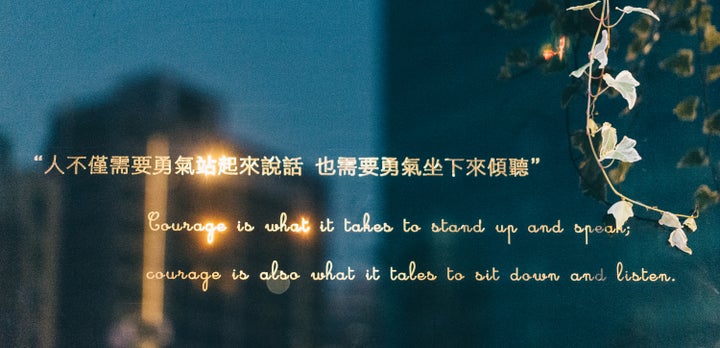
So many what-ifs went through my head while I panicked quietly. What I did not realize was that a line had already formed outside of the performance room while one of the violinists began to warm up inside. Soon, all my worries went away. People came in like waves, and that line of people waiting to enter the performance room would go on for seven hours every day over the next weeks. Crowds stood outside as the small glass rooms reached their capacity quickly. The architecture itself was also beloved. From day to night, it attracted people’s attention before they knew what the whole exhibition was about. Lots of people took pictures with it and it showed me how powerful it is when different art forms work together.
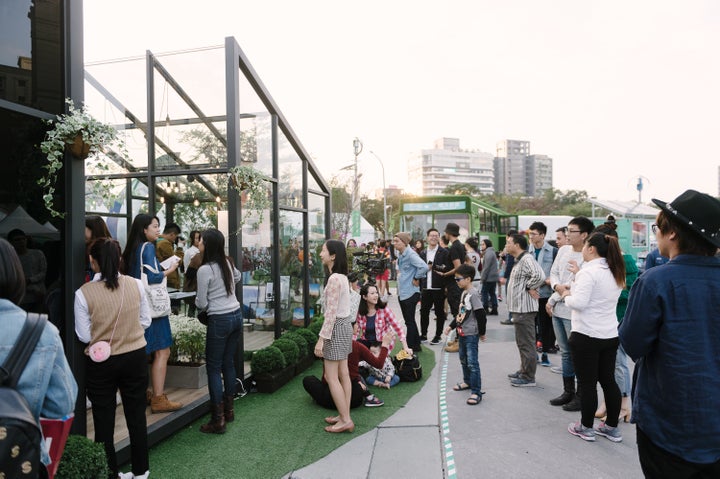
In the display room, everyone fell in love with the cello, from young kids who were smaller than the cello to their grandparents. Even the shyest visitors who were afraid of breaking the cello were willing to try with a little encouragement. I watched them sit down nervously; I watched them hold the cello and place it between their legs as gentle as if it was made of glass; I watched them listen to me tentatively while I taught them how to hold the bow. And when they finally played their first note, they laughed and my heart skipped a beat.

The laughs filled up the room and happiness was everywhere.
In my everyday life, I pick up an instrument and play, but not this is not necessarily the case of the exhibition’s visitors. One of the visitors even told me it was the first time she had ever touched a cello, but it probably would be her last time too. I understand; it is not easy to take up music professionally, but at least now there is one positive and unforgettable classical music memory in her life. Everyone who tried the cello, including this woman, were all beginners, yet they reminded us of our own clumsy and imperfect first note--that note that became the beginning of our everything. But, we have forgotten about that first note and we no longer smile after a beautiful note, because now one note isn’t enough. Almost all the musicians I know struggle with self-doubt. Without applause, how do we know if we are good? How do we know our music is needed in this world? Yet, it was so simple. We began playing because we laughed and other people laughed too, and isn’t that the best thing we can do in this world?

On the other hand, across the hallway in the performance room, people were also laughing and sometimes crying too.
Ten musicians including myself took turns performing for three days. We all had completely different styles and our programs were simply our favorite pieces, from Bach to Paganini. One of us, a pianist and composer, was even able to take requests from visitors and improvise accordingly. At first, we were all just nervously hoping that no audience would walk out on us. The next thing we know an hour had flown by already, and if not for the knock on the door by the next musician, we wouldn’t have realized we had performed for almost sixty people every hour. One minute is nothing compared to a concerto, and all of us tried to hold on to every minute as long as we could. It was not tiring at all.
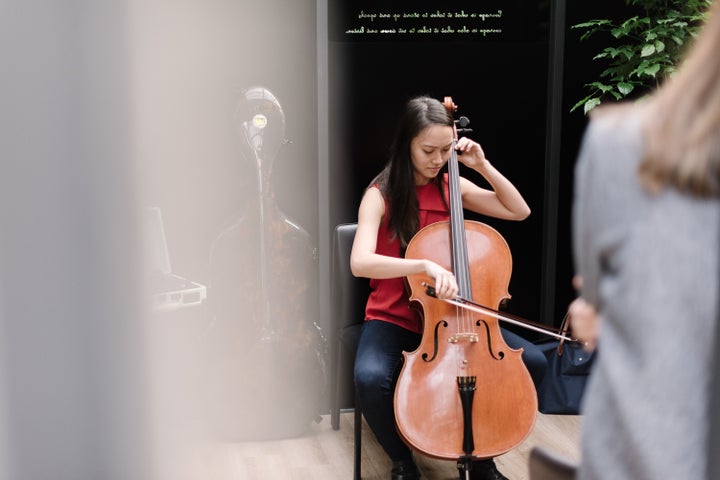
The visitors walked in with a mixture of nervous and curious expressions on their faces. They greeted us and sat down politely. Many of them commented how strangely comfortable the room made them feel, how it felt like entering a different world. Because they were still seated so close to us, we thought as soon as we started playing they would feel awkward and look away (especially in Taiwan where direct eye contact doesn’t happen easily), but none of them looked away. Instead, they looked directly into our eyes or at our hands while they listened. No one took out their phones, no one was worried about making mistakes, everyone was so focused on the very moment inside that room. I still can’t describe those moments with words; those were the most genuine and honest connections, the emotions we felt and shared were so strong that we knew the minute we finished playing that memories that will stay with us for the rest of our lives were just created.
Their reactions, questions, and even their tears brought hope back into our often tired hearts. Maybe we worried too much and we underestimated ourselves and our music; that we are still needed even if we don’t feel good enough. There was no applause or bravo after we played, because most of them had never been to a concert. They did not know the ‘correct reaction’ after a performance, so all of them said “thank you,” and some visitors even asked to touch our hands out of admiration. Their thanks were simple and their nods of admiration were subtle, but they gave us so much courage—not one of us could have possibly dreamed of this feeling.
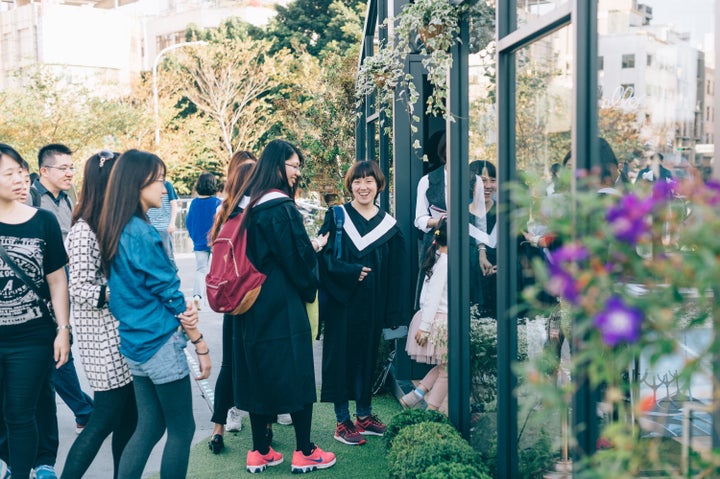
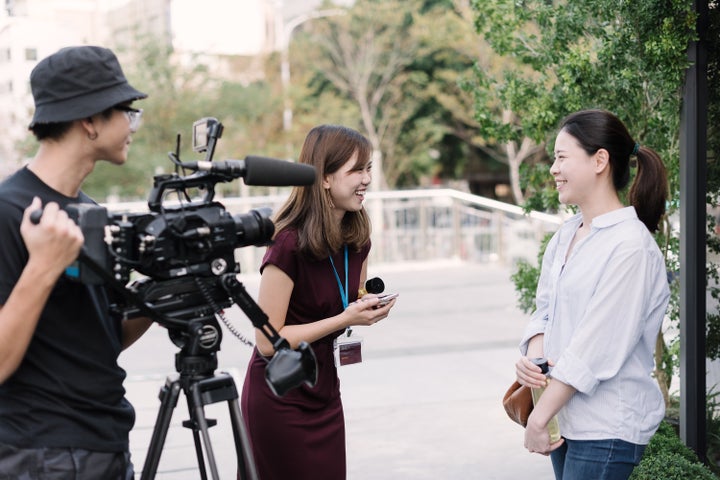
The exhibition closed on January 2nd, with a highly requested extra day of performances; the overall visitor count was 1,469 and press coverage came in from eight different online and print outlets. The exhibition gave us a chance to rethink the audience-musician relationship, it was a successful project and an interesting social experiment. There are now almost 1,000 photos on the website, and the architect’s plans and complete interviews are all included in a documentary film that were premiered in my presentation at New England Conservatory in April 2017.
Everyone had doubts, yet in those glass rooms, out of everyone’s comfort zones, we created so many “one-minutes” that will last for eternity. In the future, I have plans for more interactive and social experimental exhibitions that will bring musicians and the public closer. I hope the success of this project will raise more support and increase attention overall to classical music.
I’d like to end my thoughts with another quote, this time it is by Maestro Leonard Bernstein: “The key to the mystery of a great artist is that for reasons unknown, he will give away his energies and his life just to make sure that one note follows another... and leaves us with the feeling that something is right in the world.”
A video about Rayna’s project may be viewed below:
About Rayna Chou
Originally from Taiwan, Rayna Chou is earning a graduate degree in Viola Performance at New England Conservatory. Rayna was awarded an Entrepreneurship Grant from the Entrepreneurial Musicianship Department at New England Conservatory in Fall 2016 for ‘One Minute of Just Us’.”
